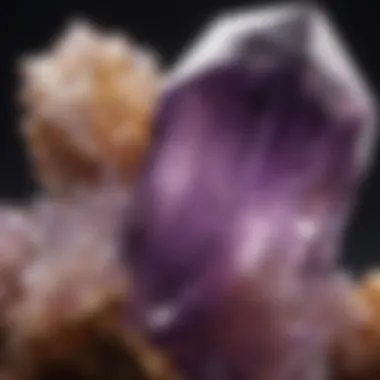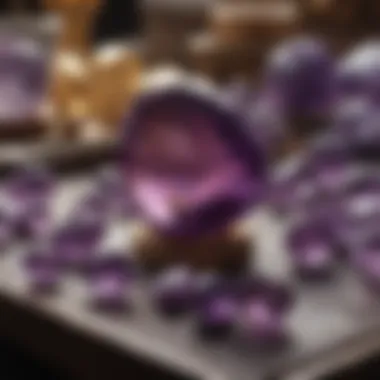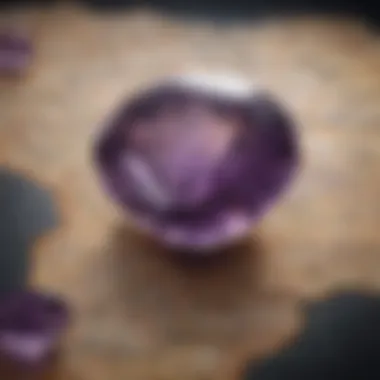Understanding Amethyst Pricing Factors and Insights


Intro
The pricing of amethyst is a complex subject influenced by various factors. Understanding these dynamics is essential for collectors and enthusiasts alike. This article will explore the several aspects that dictate market values of amethyst. From quality assessment to geographical origins, each element plays a crucial role in determining price.
As you read through the sections, you will gain insights into the significance of market trends and the impact of treatments on amethyst pricing. This knowledge will empower you, the collector, to make informed purchasing decisions.
Quality Assessment Criteria
One of the primary factors affecting amethyst pricing is its quality. Quality is determined by color, clarity, cut, and carat weight. Often, deeper colors are more desirable. Rich violet hues command higher prices compared to paler shades.
Color
Color is the most critical attribute. The most sought-after amethyst features a vibrant, saturated color. Variations in hue can affect perceived value. Subtle shifts towards red can decrease price while vivid bluish-purple tones often increase value.
Clarity
Clarity refers to the presence of inclusions or flaws within the stone. Flawless amethyst is rare and highly valued. Stones with visible inclusions generally sell for lower prices.
Cut
The cut also plays a significant role. A well-executed cut enhances the natural beauty of the stone, maximizing brilliance. Poor cuts can detract from a stone’s appearance, negatively impacting its market value.
Carat Weight
Carat weight is straightforward; larger stones typically command higher prices. However, size alone is not the sole determinant. Larger stones with poor quality may be less valuable than smaller, higher quality specimens.
Market Trends
The amethyst market is continuously evolving. Various trends influence pricing and availability. Each trend reflects changing consumer preferences and market dynamics.
Geographical Sources
Amethyst is sourced from several regions around the world. Brazil is well known for its high-quality stones, while Zambia produces stones with rich color. Geographical variations can affect pricing significantly.
The emergence of ethical sourcing has also gained importance, influencing purchasing decisions. Amethyst from sustainable sources tends to attract higher interest and prices.
Treatments and Enhancements
Amethyst can undergo treatments that enhance its appearance. Heating and radiation can intensify color but may alter market value. Untreated stones often fetch premium prices as they retain their natural characteristics.
“Understanding the treatment processes of amethyst is crucial for collectors. It impacts both aesthetics and market value.”
Guidance for Buyers and Collectors
Prospective buyers must educate themselves on the critical factors that influence amethyst pricing. Understanding quality assessment can help make informed decisions.
Tips for Buying
- Research market values: Familiarize yourself with current market trends to assess fair pricing.
- Choose reputable dealers: Ensure you buy from trusted sources for peace of mind.
- Inspect stones personally: Whenever possible, assess the quality of the stone in person to verify claims.


By being well-informed, you enhance your collection and investment in amethyst. This knowledge cultivates confidence in your purchasing decisions, leading to a more rewarding experience.
Preamble to Amethyst
Amethyst is a captivating gemstone that holds significant allure for both collectors and jewelry enthusiasts. Its luxurious purple hue and rich history make it more than just a decorative piece; it is a subject of deep fascination. Understanding amethyst is vital for anyone looking to purchase or collect this precious stone. By delving into its attributes, one can better appreciate what drives its market value.
When discussing the significance of amethyst in this context, one must consider several factors. These include its historical uses, cultural relevance, and intrinsic properties. These elements all play a role in determining how amethyst is priced today. Knowing the level of importance attached to these factors can assist buyers and collectors in making informed decisions.
Furthermore, the exploration of amethyst pricing offers a comprehensive view of the gemstone's market landscape. By learning about fluctuations in price and factors that influence these changes, one can navigate the purchasing process with confidence. The insights gained from this examination not only enhance the buying experience but also enrich one's appreciation of this beautiful stone.
To fully understand amethyst pricing, let's begin with a closer look at its significance in gemology and its fascinating historical context.
The Significance of Amethyst in Gemology
In gemology, amethyst is categorized as a variety of quartz. It is the most valuable member of the quartz family. The color of amethyst ranges from light lavender to deep violet, influenced primarily by iron impurities within its crystalline structure. This color variation plays a critical role in determining the stone's quality and pricing.
The depth of color is often assessed on a scale, with the richest hues commanding the highest prices. Amethyst also exhibits pleochroism, meaning it can show different colors when viewed from different angles. This optical phenomenon adds to its allure, making it a sought-after choice for gemstone enthusiasts.
Not only is amethyst valued for its beauty, but it is also believed to possess metaphysical properties. Many cultures have historically regarded amethyst as a protective stone, thought to promote calmness and clarity. This spiritual significance enhances its value among collectors and those interested in holistic practices.
Historical Context of Amethyst Pricing
The historical context of amethyst pricing is rich and layered. In ancient times, amethyst was highly prized, often associated with royalty and spirituality. Its name comes from the Greek word "amethystos," which translates to "not intoxicated," reflecting its purported ability to prevent drunkenness. Throughout history, this gemstone adorned the crowns of emperors and the robes of religious leaders.
In the 19th century, amethyst was declared the official birthstone for February. This gave its popularity a significant boost, influencing market demand and pricing structures. As gem exploration expanded, new sources emerged in Brazil and Africa, contributing to a surge in available supply. While this increased accessibility led to a more stabilized price range, the best-quality specimens still command high values due to their rarity.
Today, understanding the historical pricing trends of amethyst can provide insights into its current market circulation and valuation. Collectors and buyers who appreciate its legacy can make more informed decisions when purchasing amethyst, ensuring that their investment holds both aesthetic and historical worth.
Key Factors Affecting Amethyst Pricing
Understanding the pricing of amethyst requires a closer look at several key factors that influence its market value. Each aspect plays a vital role in how potential buyers perceive the stone and its worth. Evaluating these factors not only assists collectors in making informed decisions but also clarifies the broader market trends that affect the entire gem industry.
Color and Its Importance
Color remains one of the most significant elements impacting amethyst pricing. The hue of an amethyst can vary from a light lavender to a deep, rich purple. Top-tier amethysts tend to showcase a vivid purple color with slight red undertones, often considered the most desirable by collectors and gem enthusiasts alike. It's important to note that the intensity and tonality of color can appeal differently to various buyers.
Amethyst also exhibits phenomena like zoning, where the stone showcases multiple color bands within a single piece. While some may find this characteristic interesting, others may not consider stones with noticeable zoning as high quality. Therefore, understanding how color affects perception can be insightful for buyers.
Clarity: A Crucial Quality Metric
Clarity defines the presence of inclusions or blemishes within the stone. Higher clarity translates to a clearer stone, which is generally more sought after and therefore more expensive. Clarity grading takes into account visibility of any imperfections under magnification. Stones classified as "eye-clean"—those without visible imperfections to the naked eye—typically command higher prices.
A few standard grading systems are in place to help assess clarity. The Gemological Institute of America (GIA) often employs a scale to measure imperfections. For amethyst, many collectors consider stones rated as "Very Slightly Included" or better. This makes clarity an important consideration when assessing overall quality.
Cut Quality and Its Effect on Value
The cut quality of an amethyst significantly influences its overall appearance and value. A well-cut stone will exhibit brilliance and light reflection, drawing the eye. Alternatively, a poorly cut stone can diminish the visual qualities of even the most vibrantly colored amethyst. Factors affecting cut quality include proportions, symmetry, and overall craftsmanship.
Common cuts for amethyst include oval, round, pear, and emerald. Each cut emphasizes different aspects of the stone. A well-proportioned oval cut may bring out depth of color more effectively than a basic round cut. Therefore, buyers should seek to understand how cut quality alters a stone's aesthetic and, by extension, its price.
Carat Weight Considerations


Carat weight plays a fundamental role in amethyst pricing, similar to other gemstones. Generally, larger stones hold higher value due to their rarity. However, carat weight must be considered alongside other quality metrics like color, clarity, and cut. A large stone that lacks depth of color or clarity may not necessarily yield a higher price.
Often, price increases are not linear with carat weight. For example, a 10-carat amethyst may cost exponentially more than a 5-carat version due to increased demand and rarity. Thus, potential buyers must balance carat weight with desired quality to make judicious purchasing decisions.
Market Trends in Amethyst Pricing
Understanding market trends in amethyst pricing is essential for collectors and investors alike. Such trends inform about current market conditions, potential future prices, and investment opportunities. By examining the dynamics of current pricing, geographical differences, and the influence of supply and demand, readers can gain insights that help guide their purchasing decisions.
Current Pricing Trends and Data Analysis
In recent years, the market for amethyst has seen noticeable fluctuations. Current prices often depend on several factors including quality, origin, and market demand. For instance, high-quality amethysts from Brazil and Uruguay are currently valued more highly due to their rich color and clarity.
A recent report indicates that average prices for amethyst have been steadily increasing, especially for larger stones. In contrast, smaller, lower-quality stones have not seen the same growth, indicating a differentiated market. Collectors should be aware of these nuances when assessing the potential value of amethysts. For a thorough pricing trend analysis, data from resources such as en.wikipedia.org or britannica.com can offer valuable historical context and statistical backing.
Geographic Variations in Price
The geographic source of amethyst significantly influences its pricing. Origins such as Brazil, Uruguay, and Africa contribute to different pricing structures. For instance, Brazilian amethyst is often priced higher due to its popularity, while African varieties might offer more affordability but with varying quality metrics.
"The value of amethyst can vary widely based on where it is sourced, as different locations are renowned for distinct qualities."
Regional availability and mining practices also affect the cost. Areas with established mining operations are more likely to produce stones that meet quality standards at competitive prices. As a collector, it is prudent to research and understand these geographic differences to make informed purchasing decisions.
Impact of Supply and Demand Dynamics
The relationship between supply and demand plays a critical role in driving amethyst prices. When the supply of high-quality amethyst decreases—due to factors like mining regulations or natural disasters—the price tends to increase. Conversely, when demand surges, such as during jewelry trends or gemstone exhibitions, prices can escalate quickly.
Factors that influence demand include:
- Consumer preferences for gemstones in fashion.
- The introduction of new jewelry designs.
- Economic conditions that affect luxury goods spending.
Awareness of these supply-demand dynamics is essential. Collectors should monitor market trends closely as they can provide early indicators of potential price movements.
Amethyst Treatment and Enhancement
Amethyst treatment and enhancement is a significant aspect in understanding the pricing of this popular gemstone. Treatments can alter the appearance of amethyst, thus affecting its market value. Knowing these treatments empowers buyers, allowing them to make informed purchases. It is essential to differentiate between natural and treated stones, as treatments can vary in both method and degree.
Popular Treatment Methods
There are several treatment methods used to enhance amethyst. Each method has its own implications for quality and pricing.
- Heat Treatment: This process involves exposing amethyst to high temperatures. It can intensify the color, often resulting in richer shades of purple. Heat-treated amethyst can sell for significantly more than untreated stones of lesser color.
- Irradiation: This technique is used to modify color by exposing amethyst to radiation. The result is typically an enhancement of the violet hues or alteration of color to create a more desirable shade.
- Coating: Some amethyst stones have a coating applied to improve appearance. This treatment may enhance brilliance or alter color. However, it can decrease the durability of the stone and should be purchased with caution.
These methods are widely recognized in the gemological community. Buyers should always inquire about treatment history when assessing amethyst.
Effects of Treatments on Value
Treatments can have a profound impact on the value of amethyst. Understanding this influence is vital for both buyers and collectors.
- Value Increase for Quality Colors: Heat-treated amethyst with vibrant colors can command higher prices. Stones that undergo heat treatment often exhibit properties comparable to natural stones, making them more desirable.
- Devaluation from Coatings: Amethyst with a coating can experience a drop in value. While they may look appealing, the added material can make these stones less durable and less sought after in the market.
- Market Preferences: The preference for natural over treated stones creates fluctuations in price. Buyers willing to pay a premium for untreated stones will find their market influence the overall pricing.


In summary, treatment methods shape not only the appearance of amethyst but also its economic value. Being aware of these factors and their implications can greatly enhance a collector's purchasing decisions.
Understanding the treatment history of amethyst is crucial for making informed choices. Take time to research and inquire about the origin and treatment of your gemstone to ensure quality and fair pricing.
Guidance for Amethyst Buyers and Collectors
The realm of amethyst buying can present challenges for both newcomers and seasoned collectors. Understanding the nuances associated with this gemstone is essential for making informed purchasing decisions. This section focuses on key elements that can benefit buyers and enhance their collecting experience. Collectors need to comprehend quality metrics, market variability, and the long-term implications when investing in amethyst. Proper guidance can ultimately lead to acquiring valuable specimens and building a meaningful collection.
Assessing Quality Before Purchase
Before acquiring an amethyst, buyers must rigorously assess its quality. Key factors to evaluate include color, clarity, cut, and carat weight.
- Color: Ideal shades often range from a deep purple to a lighter lavender, with even tones being more desirable.
- Clarity: Flaws or inclusions can affect the overall beauty and value of the stone. Clear stones command higher prices.
- Cut: The precision of the cut influences light performance, affecting the gemstone’s visual appeal.
- Carat Weight: Larger stones are typically more valuable, but quality should not be compromised for size alone.
Buyers should consider obtaining a certification from a reputable gemological laboratory, like the Gemological Institute of America, to ensure the authenticity and quality of the gemstone.
Sources for Reliable Pricing Information
Gathering trustworthy pricing information is crucial for buyers. A well-informed buyer can avoid pitfalls when evaluating amethyst prices. Reliable sources may include:
- Retail Jewelers: Excellent for observing market trends and average prices within local areas.
- Online Marketplaces: Websites such as eBay or specialized gemstone platforms can give insights into current market values.
- Gem Shows: Attending gem and mineral shows can provide firsthand exposure to pricing and trends.
- Price Guides: Utilizing guides like the International Gem Society’s pricing tables can help establish an understanding of fair market prices.
Acknowledge that prices can fluctuate based on market dynamics and conditions. It is advisable to cross-reference multiple sources to ensure accuracy.
Building a Collection: Long-term Considerations
Developing an amethyst collection necessitates strategic foresight. Long-term considerations include:
- Quality over Quantity: It is preferable to own fewer high-quality pieces than numerous inferior stones.
- Storage Conditions: Proper storage conditions, such as avoiding direct sunlight and high humidity, preserve the stone’s integrity.
- Documentation: Keeping detailed records of purchases, including prices and certificates, can aid in assessing investment value over time.
- Diversification: Consider branching into different gemstones or types of amethyst unique to specific locations. This creates a richer and more engaging collection.
Ultimately, a thoughtful approach to collecting amethyst can lead to long-term enjoyment and potential financial benefits. Being well-informed, always reassessing goals, and understanding the market are essential for success in this venture.
By focusing on quality assessments, reliable pricing avenues, and long-term strategies, buyers can navigate the complexities of amethyst collection more effectively.
Closure
Understanding the nuances of amethyst pricing is essential for buyers and collectors alike. This section aims to summarize the key insights gathered throughout the article. By synthesizing the intricate factors influencing market values, it becomes clear how quality metrics, treatment methods, and market dynamics play significant roles in pricing.
Summarizing Pricing Insights
Amethyst pricing is not static. Various variables contribute to the fluctuations in value. Color, clarity, cut quality, and carat weight are foundational elements that influence a stone's worth.
- Color: The depth and saturation of violet hues are paramount.
- Clarity: Fewer inclusions result in higher prices.
- Cut Quality: Precision in the cutting process enhances brilliance, adding value.
- Carat Weight: Larger stones naturally command higher prices.
Moreover, the geographical origin affects pricing significantly. For instance, amethysts sourced from Brazil or Uruguay might have different market values due to their rarity and perceived quality. Recognizing these key factors allows collectors to make informed purchasing decisions, ultimately optimizing their collections.
Future Outlook for Amethyst Pricing
The future of amethyst pricing appears promising yet uncertain. Current trends suggest a potential rise in demand, driven by both collectors and casual buyers. Increased interest in natural gemstones can lead to variations in market prices. The potential impact of new mining discoveries or enhanced treatments deserves attention.
As global markets evolve, it’s vital for collectors to stay informed. Factors such as economic conditions, shifts in consumer preferences toward sustainable sourcing, and technological advancements in gem enhancement could reshape the pricing landscape.
Keeping abreast of these trends will equip collectors with the knowledge needed to navigate their investments successfully.
"For informed buying, understanding the future dynamics of the market is as crucial as recognizing the present value of amethyst."
In summary, the nuances of amethyst pricing require careful consideration, detailed knowledge, and an understanding of market trends. Collectors should continue to educate themselves about the changing landscape, ensuring that they make savvy decisions moving forward.







